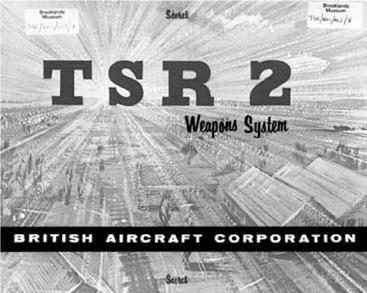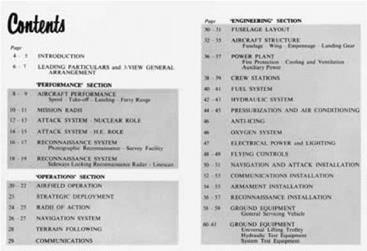Tabular Hierarchy
Look now at exhibit 2.8, which reproduces the table of contents of the brochure. This makes more links, coordinates further versions of the TSR2. But how does it produce its coordinating effects?
Michel Foucault offers us the classic response. A table constitutes and juxtaposes components in a two-dimensional array. It generates 18 Objects new forms of visibility, new visual relations, which means that it cre-
|
|
|


ates a subject position that escapes the linearity and the syntax of text by virtue of its construction as an overall vantage point. This means, to use another metaphor, that a table draws things together. It draws them together by juxtaposing them spatially and by assuming, in that juxtaposition and ordering, that they are in some way linked. It thus performs the assumption that the different elements listed are simi-
lar in kind. And in the present instance, if one makes the link back to the framing of the brochure, that they concern the TSR2 in one way or another.
So the table implies and performs a form of coordination. When nouns and the different specific object positions appear in a list or a table, they are being made to go together. But this is simply a first step. For in the present instance at least, these relations of visual simultaneity also perform relations of hierarchy. Components of the table, its elements, are being coordinated in ways that assure their asymmetry. Thus, it is not simply that what become the more important features of the object tend to come in the earlier pages of the brochure (though this is certainly one of the effects being achieved, both in the table of contents and in the overall structure of the publication). It is also that the elements in the table are ranked into three different levels. There are the three main sections, on “Performance,” “Operations,” and “Engineering”; a number of subsections, such as ‘‘Aircraft Performance,” ‘‘Radii of Action,’’ and ‘‘Ground Equipment’’; and then there are subsections to those subsections, which have to do with objects such as ‘‘fire protection’’ or ‘‘system test equipment.’’
So the table of contents, by virtue of its visible organization, not only homogenizes, not only proposes that everything in the table somehow or other goes together, but also makes a hierarchy in three levels. This means that the table of contents is like an organizational chart or an arborescence:5 the various elements are being defined, performed, and indeed guaranteed. Smaller parts are being ‘‘included” in the larger sections. They become specific ‘‘aspects” of larger unities—and, no doubt, of the TSR2 aircraft as a whole. Thus the reader is readily able to see that what has now become ‘‘the top” depends on, or is composed by, the links between a series of more specific components that have their role to play in the system ‘‘as a whole.”
In short, the table is a third strategy for coordinating disparate objects and relating them together to form a unity. And the particular alchemy of the table is the way in which it returns, constantly, to that which is made central—ultimately, though here implicitly, the TSR2 — and performs what, echoing Jacques Derrida’s concern with necessary slippage (1978), one might think of as strategic deferral, for 20 Objects that which is left out is performed as ‘‘detail,’’ as ‘‘technical detail.’’
Note that the logic of strategic deferral—and the way in which it produces subject and object centering—extends beyond the covers of the brochure. For if this is only sixty pages long, then much must be excluded from its pages and deferred because it is ‘‘less important” or ‘‘relevant’’ than what is mentioned. Nevertheless (and here is the assumption of this strategy for coordinating, which is also a guarantee), it might be unpacked if the curious chose to look at “supplementary documentation” in some ‘‘technical manual’’ for reasons that are made to be good because, for a complex object such as an aircraft, it is important to perform links that are many layers down the hierarchical-technical system.
To summarize: the table, its structure, and its deferrals produce a hierarchy that generates a subject that has focus but also a coordinated object, one that hangs together because it has been constituted as a set of hierarchically related parts or aspects that combine to produce a unitary whole.6











